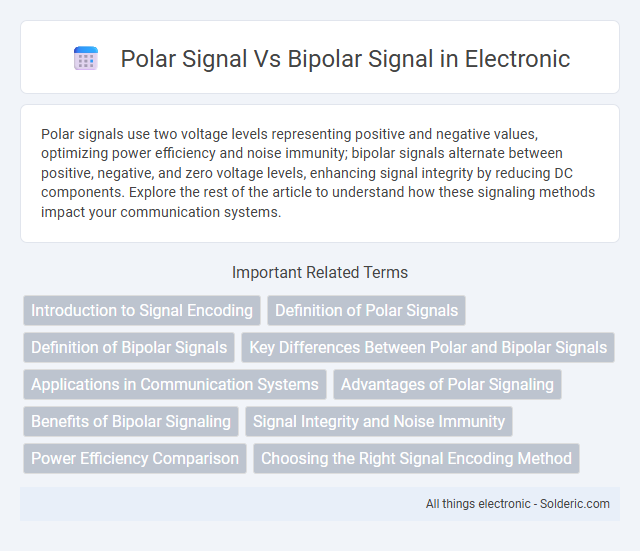Polar signals use two voltage levels representing positive and negative values, optimizing power efficiency and noise immunity; bipolar signals alternate between positive, negative, and zero voltage levels, enhancing signal integrity by reducing DC components. Explore the rest of the article to understand how these signaling methods impact your communication systems.
Comparison Table
| Feature | Polar Signal | Bipolar Signal |
|---|---|---|
| Signal Levels | Two levels: positive and negative voltage | Three levels: positive, zero, and negative voltage |
| Voltage Usage | Uses positive and negative voltages | Uses positive, zero, and negative voltages |
| DC Component | Possible DC component | Reduced or no DC component |
| Signal Synchronization | Less efficient synchronization | Better synchronization due to alternating polarity |
| Error Detection | No inherent error detection | Inherent error detection capability via bipolar violations |
| Complexity | Lower complexity | Higher complexity |
| Example Encoding | Non-Return-to-Zero (NRZ) Polar | Alternate Mark Inversion (AMI) |
Introduction to Signal Encoding
Polar signals use two distinct voltage levels, typically positive and negative, to represent binary data, enhancing noise immunity and signal clarity. Bipolar signals alternate between positive, negative, and zero voltage levels, enabling error detection and reduced DC components in transmission lines. Understanding the differences between polar and bipolar signal encoding can help you optimize digital communication systems for reliability and efficiency.
Definition of Polar Signals
Polar signals represent digital data using two distinct voltage levels, one positive and one negative, corresponding to binary values 1 and 0, respectively. This method contrasts with unipolar signals, which use a single positive voltage and zero for representation, while bipolar signals alternate between positive, zero, and negative voltages to indicate different states. Your choice between polar and bipolar signaling affects signal integrity and noise immunity in digital communication systems.
Definition of Bipolar Signals
Bipolar signals alternate between positive and negative voltage levels, with no presence of a zero voltage state during transmission. This signal type uses two distinct polarities to represent binary data, typically mapping one polarity to binary '1' and the other to binary '0'. Your communication system benefits from bipolar signals by reducing the DC component and improving error detection through inherent polarity reversals.
Key Differences Between Polar and Bipolar Signals
Polar signals represent binary data using two voltage levels, typically positive and zero volts, while bipolar signals use three voltage levels, including positive, negative, and zero volts. Polar signaling offers simpler implementation but may suffer from baseline wander, whereas bipolar signaling reduces DC component and improves error detection through the use of alternating positive and negative pulses. The choice between polar and bipolar signaling significantly impacts signal integrity, bandwidth efficiency, and the complexity of the communication system.
Applications in Communication Systems
Polar signals, characterized by two voltage levels representing binary states, are widely used in digital communication systems for their noise immunity and ease of synchronization. Bipolar signals employ three voltage levels, which help reduce DC components and signal distortion, making them suitable for long-distance transmission and high-speed data communication such as T-carrier lines. Both signal types optimize bandwidth and error detection in different communication protocols, enhancing overall system performance.
Advantages of Polar Signaling
Polar signaling offers improved noise immunity compared to bipolar signaling, making it ideal for long-distance communication. It provides better voltage utilization by using both positive and negative voltages, enhancing signal clarity and reducing error rates. The consistent voltage levels of polar signals enable more efficient power consumption and simpler receiver design.
Benefits of Bipolar Signaling
Bipolar signaling reduces DC component and signal distortion, making it ideal for long-distance communication and improving error detection. It enhances bandwidth efficiency by using three voltage levels, which minimizes electromagnetic interference compared to polar signals. Your communication systems benefit from increased reliability and better noise immunity with bipolar signaling.
Signal Integrity and Noise Immunity
Polar signals exhibit higher noise immunity due to their voltage levels being referenced to a common ground, which reduces susceptibility to external interference. Bipolar signals enhance signal integrity by utilizing both positive and negative voltage levels, allowing better distinction between logic states and minimizing distortion over long distances. For your applications requiring robust communication, understanding these differences ensures optimal signal performance in noisy environments.
Power Efficiency Comparison
Polar signals exhibit higher power efficiency compared to bipolar signals since they utilize only one voltage polarity, reducing power dissipation in the transmission medium. In contrast, bipolar signals alternate between positive and negative voltages, often requiring more power to maintain signal integrity over long distances. Consequently, polar signaling is preferred in systems demanding energy conservation and minimized power loss.
Choosing the Right Signal Encoding Method
Polar signals use two voltage levels representing binary values, which provides better noise immunity and power efficiency compared to unipolar signals. Bipolar signals employ three voltage levels including positive, negative, and zero, reducing DC bias and enabling easier error detection through alternate mark inversion techniques. Selecting the appropriate encoding method depends on transmission distance, noise conditions, and system complexity, with polar signals favoring simpler applications and bipolar signals suited for high-speed or long-distance communication.
polar signal vs bipolar signal Infographic

 solderic.com
solderic.com